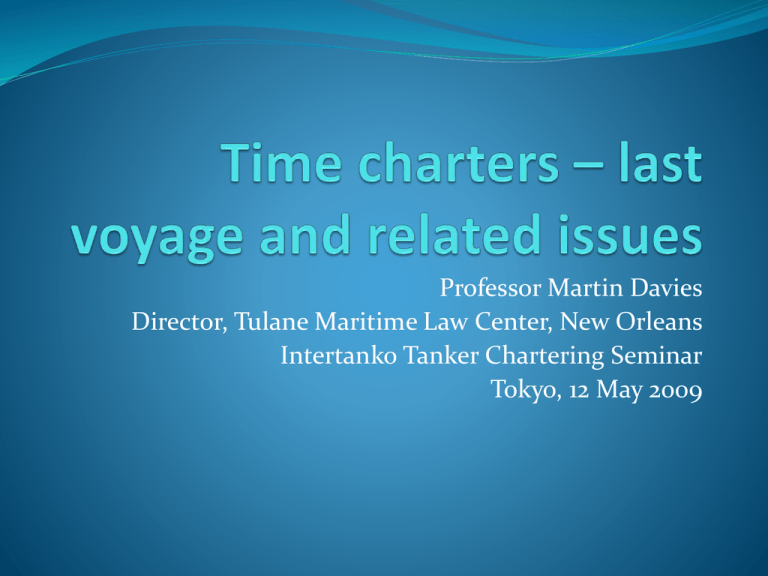Time charters * last voyage and related issues
advertisement

Professor Martin Davies Director, Tulane Maritime Law Center, New Orleans Intertanko Tanker Chartering Seminar Tokyo, 12 May 2009 Outline Overlap/underlap – how long is the charter period? Late redelivery Legitimate last voyage Contractual extensi0ns of charterer’s right Early redelivery 2 Overlap/underlap A reasonable overlap/underlap is implied in charters for a fixed period (now unusual) Charter may provide for overlap/underlap “about 12 months” “12 months, 15 days more or less” “11 months minimum, 13 months maximum” If overlap/underlap is specifically stated, no additional “reasonable” tolerance The Dione [1975] 1 Lloyd’s Rep. 115 Prebensens Damps A/S v. Munson Line, 258 F. 227 (2d Cir. 1919) But…. 3 Overlap/underlap An implied additional tolerance will be added to the stated overlap/underlap if the charter so provides The Peonia [1991] 1 Lloyd’s Rep. 100 “about minimum 10 months, maximum 12 months” Word “about” added “an additional margin or tolerance” (Practice tip: Don’t repeat yourself; don’t say things twice when you only mean it once.) 4 Overlap/underlap Renewal of a charter term – one or two overlaps? The Aspa Maria [1976] 2 Lloyd’s Rep. 643 “6 months, 30 days more or less” Option to renew “for a further six months, 30 days” 12 months, 60 days or 12 months, 30 days? CA held: 12 months, 30 days Overlap period does not extend charter period, merely creates a period of tolerance for redelivery But… 5 Overlap/underlap Other clauses may extend the charter period Overlap is then added to the end of the extended period The Kriti Akti [2004] 1 Lloyd’s Rep. 712 “11 months, 15 days more or less” Off-hire clause gave charterer the option to add off-hire periods to the charter period Charterer added 36 days of off-hire to the charter period; wanted 15 days overlap as well CA held: 11 months, 51 days 36 days extended charter period, 15 days tolerance in redelivery 6 Late redelivery When the market rate is higher than the contract rate “Final terminal date” (FTD) The Peonia, per Bingham LJ The end of the overlap period, stated and/or implied Legitimate last voyage There is a reasonable expectation when the order is given that the voyage will be completed before the FTD (Unless charter gives charterer more extensive right – more on that later) LLV is completed at the contract rate, not the market rate 7 Illegitimate last voyage The order itself is probably a breach of contract by the charterer Whether or not the order is a breach of contract, owner/master is entitled to refuse to accept it Demand an alternative, legitimate last voyage order If charterer insists on the order despite the owner’s request, that is definitely a repudiatory breach Owner entitled to bring the contract to an end at that time The Gregos [1994] 1 Lloyd’s Rep 1, 10 per Lord Mustill 8 Legitimate becomes illegitimate What happens when a legitimate order becomes illegitimate? Last voyage order is legitimate when the order is given Reasonable expectation at that time of completion before FTD Illegitimate when the time for performance comes No longer any reasonable expectation of completion before FTD (Therefore, some unexpected delay between giving of order and time for performance) Can charterer insist on completion of the voyage at the contract rate because the order was legitimate when given? 9 Legitimate becomes illegitimate The Gregos [1994] 1 Lloyd’s Rep. 1 Charterer obliged to give a new order, replacing the original one with an order for a voyage reasonably likely to be completed before FTD If charterer refused, owner can treat charter as at an end at that moment and perform no further voyage at all 10 Accepting the illegitimate Owner accepts illegitimate last voyage order but reserves right to claim damages Charterer must pay market rate from… FTD? Date when redelivery would actually have taken place if illegitimate last voyage had not been performed? Usually earlier than FTD The Black Falcon [1991] 1 Lloyd’s Rep. 77: from FTD – charterer gets ship at contract rate until FTD 11 Delayed LLV What happens if an LLV is not completed by the FTD? Some unexpected delay on the last voyage Charterer still in breach, even if neither party is responsible for the delay The Peonia Owner cannot complain if it is responsible for the delay Charter continues until redelivery but charterer must pay damages Market minus contract from FTD until redelivery If contract is above market, charterer must pay contract rate until redelivery because contract continues until then (The London Explorer [1972] AC 1) Unless the charter gives charterer a more far-reaching right re last voyage orders… 12 Shelltime 3 Clause 3: period and trading limits Clause 18: “Notwithstanding the provisions of clause 3 hereof, should the vessel be upon a voyage at the expiry of the period of this charter, charterers shall have the use of the vessel at the same rate and conditions for such extended time as may be necessary for the completion of the round voyage on which she is engaged and her return to a port of redelivery as provided by this charter…” 13 The Kriti Akti (2004) Remember that CA held that “the period of the charter” was 11 months, 36 days 11 months plus 36 days’ worth of off-hire time added at charterer’s option FTD was 11 months plus 51 days 11 months + 36 days off-hire + 15 days overlap Charterer ordered Kriti Akti on voyage that would not be completed until well after FTD Order given after basic 11 months had expired Did “the period of this charter” mean 11 months, 11 months + 36 days, or 11 months + 51 days? 14 The Kriti Akti (2004) “The period of this charter” meant 11 months + 51 days As a general principle, charterer is entitled to give orders during the overlap period for an LLV In Shelltime 3, cl. 18 extended the charterer’s right to give orders to include orders for what would otherwise be an ILV “Owners are thereby exposed to a final round voyage of no fixed length, which it is clear from the outset will extend very considerably beyond the final terminal date.” Mance LJ, [2004] 1 Lloyd’s Rep. 712, 718 15 Similar results in New York In re Sun Overseas Transport Ltd and Amerada Hess Shipping Corp. (The Pacific Sun), 1983 AMC 830 (N.Y. Arb. 1982) In re Gotco N.V. and Texaco Panama, Inc. (The Narnian Sea), 1991 AMC 274 (N.Y. Arb. 1990) Similar results re similar clause in Texacotime 2 (cl. 11) 16 Shelltime 4 Clause 19: “If at the time this charter would otherwise terminate in accordance with Clause 4 the vessel is on a ballast voyage to a port of redelivery or is upon a laden voyage, charterers shall continue to have the use of the vessel at the same rate and conditions as stated herein for as long as necessary to complete such ballast voyage, or to complete such laden voyage and return to a port of redelivery as provided by this charter as the case may be.” Narrower than Shelltime 3, cl. 18 17 The Ambor/The Once Marimpex v. Compagnie de Gestion et d’Exploitation Ltd [2001] 1 All E.R. (Comm.) 182 Charter period 12 months +/- 20 days, with an additional option of 6 months FTD was 17 February 1989 On 16 December 1988 (during basic 12-month period), charterers gave voyage orders that contemplated redelivery on about 7 March 1989 Owners ordered master not to comply Charterers redelivered on 14 January 1989, within overlap/underlap Was this order legitimate under Shelltime 4, cl. 19? Same result as Shelltime 3, cl. 18, or different? 18 The Ambor/The Once Clause 19 not clear enough or specific enough to protect charterer from consequences of ordering what would otherwise be an ILV Shelltime 4, cl. 19 was unlike Shelltime 3, cl. 18 Did not begin with the words “Notwithstanding the provisions of clause 3 hereof…” Only applies when vessel is on a voyage (laden or ballast to redelivery) at FTD Does not extend charterer’s right to order vessel on last voyage beyond FTD 19 Similar results in New York In re Addison Shipping & Trading S.A. and Bayoil Supply and Trading Ltd (The Sea World), S.M.A. Arb. 3791 (June 10, 2003) In re U.S. Titan, Inc. and Iino Kaiun Kaisha Ltd (The Seto Bride), S.M.A. Arb. 3149 (Feb. 15, 1995) Shelltime 4, cl. 19 interpreted in same way as in The Ambor/The Once “Clause 19 is not intended to legitimize an illegitimate last voyage, but to cover what happens due to an unforeseeable delay once a last voyage has already begun.” (The Seto Bride) 20 Practice tip If you are an owner, use Shelltime 4 (or at least cl. 19) If you are a charterer, use Shelltime 3 (or at least cl. 18) 21 Early redelivery When the contract rate is higher than the market rate Underlap – earliest possible redelivery Redelivery before underlap is a repudiatory breach of charter Owner does not want to accept that repudiation as bringing contract to an end Owner only entitled to affirm contract after repudiatory breach if it has a “legitimate interest” in keeping the contract alive Is the owner’s interest in continuing to receive contract hire a “legitimate interest”? 22 Early redelivery The Dynamic [2003] 2 Lloyd’s Rep. 693 Principles governing exception to general rule that owner has an option whether to accept repudatiory breach as terminating Burden is on charterer to show that owner has no legitimate interest in performing contract rather than claiming damages Burden not discharged merely by showing that the benefit to the owner is small compared to the loss to the charterer Owner can only be forced to accept repudiatory redelivery in “extreme cases” – where damages would be an adequate remedy and where an election to keep the contract alive would be unreasonable Whether charterer entitled to redeliver early under trip time charter when vessel arrested (by charterer) before reaching redelivery point Remitted to arbitrators 23


